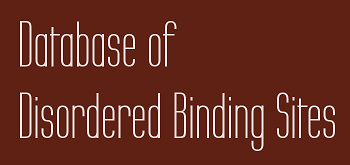



Database Accession: DI1010046
Name: 4E-BP1 peptide bound to EIF4E
PDB ID: 1ej4
Experimental method: X-ray (2.25 Å)
Source organism: Homo sapiens / Mus musculus
Proof of disorder:
Kd: 5.00×10-08 M
Primary publication of the structure:
Marcotrigiano J, Gingras AC, Sonenberg N, Burley SK
Cap-dependent translation initiation in eukaryotes is regulated by a molecular mimic of eIF4G.
(1999) Mol. Cell 3: 707-16
PMID: 10394359
Abstract:
eIF4G uses a conserved Tyr-X-X-X-X-Leu-phi segment (where X is variable and phi is hydrophobic) to recognize eIF4E during cap-dependent translation initiation in eukaryotes. High-resolution X-ray crystallography and complementary biophysical methods have revealed that this eIF4E recognition motif undergoes a disorder-to-order transition, adopting an L-shaped, extended chain/alpha-helical conformation when it interacts with a phylogenetically invariant portion of the convex surface of eIF4E. Inhibitors of translation initiation known as eIF4E-binding proteins (4E-BPs) contain similar eIF4E recognition motifs. These molecules are molecular mimics of eIF4G, which act by occupying the same binding site on the convex dorsum of eIF4E and blocking assembly of the translation machinery. The implications of our results for translation initiation are discussed in detail, and a molecular mechanism for relief of translation inhibition following phosphorylation of the 4E-BPs is proposed.
 Annotations from the GeneOntology database. Only terms that fit at least two of the interacting proteins are shown.
Annotations from the GeneOntology database. Only terms that fit at least two of the interacting proteins are shown. Molecular function:
enzyme binding  Interacting selectively and non-covalently with any enzyme.
Interacting selectively and non-covalently with any enzyme.
translation initiation factor binding  Interacting selectively and non-covalently with a translation initiation factor, any polypeptide factor involved in the initiation of ribosome-mediated translation.
Interacting selectively and non-covalently with a translation initiation factor, any polypeptide factor involved in the initiation of ribosome-mediated translation.
Biological process:
negative regulation of translation  Any process that stops, prevents, or reduces the frequency, rate or extent of the chemical reactions and pathways resulting in the formation of proteins by the translation of mRNA.
Any process that stops, prevents, or reduces the frequency, rate or extent of the chemical reactions and pathways resulting in the formation of proteins by the translation of mRNA.
positive regulation of mitotic cell cycle  Any process that activates or increases the rate or extent of progression through the mitotic cell cycle.
Any process that activates or increases the rate or extent of progression through the mitotic cell cycle.
cellular response to dexamethasone stimulus  Any process that results in a change in state or activity of a cell (in terms of movement, secretion, enzyme production, gene expression, etc.) as a result of a dexamethasone stimulus.
Any process that results in a change in state or activity of a cell (in terms of movement, secretion, enzyme production, gene expression, etc.) as a result of a dexamethasone stimulus.
Cellular component:
membrane-bounded organelle  Organized structure of distinctive morphology and function, bounded by a single or double lipid bilayer membrane. Includes the nucleus, mitochondria, plastids, vacuoles, and vesicles. Excludes the plasma membrane.
Organized structure of distinctive morphology and function, bounded by a single or double lipid bilayer membrane. Includes the nucleus, mitochondria, plastids, vacuoles, and vesicles. Excludes the plasma membrane.
 Structural annotations of the participating protein chains.
Structural annotations of the participating protein chains.Entry contents: 2 distinct polypeptide molecules
Chains: B, A
Notes: No modifications of the original PDB file.
Name: Eukaryotic translation initiation factor 4E-binding protein 1
Source organism: Homo sapiens
Length: 14 residues
Sequence: Sequence according to PDB SEQRESRIIYDRKFLMECRN
Sequence according to PDB SEQRESRIIYDRKFLMECRN
UniProtKB AC: Q13541 (positions: 51-64) Coverage: 11.9%
UniRef90 AC: UniRef90_Q13541 (positions: 51-64)
Name: Eukaryotic translation initiation factor 4E
Source organism: Mus musculus
Length: 186 residues
Sequence: Sequence according to PDB SEQRESEHYIKHPLQNRWALWFFKNDKSKTWQANLRLISKFDTVEDFWALYNHIQLSSNLMPGCDYSLFKDGIEPMWEDEKNKRGGRWLITLNKQQRRSDLDRFWLETLLCLIGESFDDYSDDVCGAVVNVRAKGDKIAIWTTECENRDAVTHIGRVYKERLGLPPKIVIGYQSHADTATKSGSTTKNRFVV
Sequence according to PDB SEQRESEHYIKHPLQNRWALWFFKNDKSKTWQANLRLISKFDTVEDFWALYNHIQLSSNLMPGCDYSLFKDGIEPMWEDEKNKRGGRWLITLNKQQRRSDLDRFWLETLLCLIGESFDDYSDDVCGAVVNVRAKGDKIAIWTTECENRDAVTHIGRVYKERLGLPPKIVIGYQSHADTATKSGSTTKNRFVV
UniProtKB AC: P63073 (positions: 32-217) Coverage: 85.7%
UniRef90 AC: UniRef90_P63073 (positions: 32-217)
 Evidence demonstrating that the participating proteins are unstructured prior to the interaction and their folding is coupled to binding.
Evidence demonstrating that the participating proteins are unstructured prior to the interaction and their folding is coupled to binding. Chain B:
The interacting region of 4E-BP1 has been shown to be intrinsically disordered (PMID: 9684899 and PMID: 10394359). The 1-118 region described in IDEAL entry IID00170 covers 100% of the sequence present in the structure. The protein region involved in the interaction contains a known functional linear motif (LIG_eIF4E_1).
Chain A:
The IF4E domain involved in the interaction is known to adopt a stable structure in isolation (see Pfam domain PF01652). A solved monomeric structure of the domain from a homologous protein is represented by PDB ID 3tf2.
 Structures from the PDB that contain the same number of proteins, and the proteins from the two structures show a sufficient degree of pairwise similarity, i.e. they belong to the same UniRef90 cluster (the full proteins exhibit at least 90% sequence identity) and convey roughly the same region to their respective interactions (the two regions from the two proteins share a minimum of 70% overlap).
Structures from the PDB that contain the same number of proteins, and the proteins from the two structures show a sufficient degree of pairwise similarity, i.e. they belong to the same UniRef90 cluster (the full proteins exhibit at least 90% sequence identity) and convey roughly the same region to their respective interactions (the two regions from the two proteins share a minimum of 70% overlap). The structure can be rotated by left click and hold anywhere on the structure. Representation options can be edited by right clicking on the structure window.
